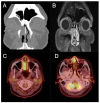Sinonasal Inverted Papilloma and Squamous Cell Carcinoma: Contemporary Management and Patient Outcomes
- PMID: 35565324
- PMCID: PMC9102473
- DOI: 10.3390/cancers14092195
Sinonasal Inverted Papilloma and Squamous Cell Carcinoma: Contemporary Management and Patient Outcomes
Abstract
Inverted papillomas (IP) are the most common sinonasal tumor with a tendency for recurrence, potential attachment to the orbit and skull base, and risk of malignant degeneration into squamous cell carcinoma (SCC). While the overall rate of recurrence has decreased with the widespread adoption of high-definition endoscopic optics and advanced surgical tools, there remain challenges in managing tumors that are multiply recurrent or involve vital neurovascular structures. Here, we review the state-of-the-art diagnostic tools for IP and IP-degenerated SCC, contemporary surgical management, and propose a surveillance protocol.
Keywords: Schneiderian; endoscopic; open; papilloma; recurrence; sinonasal; tumor.
Conflict of interest statement
The authors declare no conflict of interest.
Figures









Similar articles
-
Survival outcomes after endoscopic resection for sinonasal squamous cell carcinoma arising on inverted papilloma.Head Neck. 2016 Nov;38(11):1604-1614. doi: 10.1002/hed.24481. Epub 2016 May 6. Head Neck. 2016. PMID: 27152722
-
A clinical analysis of sinonasal squamous cell carcinoma: a comparison of de novo squamous cell carcinoma and squamous cell carcinoma arising from inverted papilloma.Acta Otolaryngol. 2020 Aug;140(8):706-711. doi: 10.1080/00016489.2020.1758342. Epub 2020 May 13. Acta Otolaryngol. 2020. PMID: 32400256
-
Serum squamous cell carcinoma antigen is a useful biologic marker in patients with inverted papillomas of the sinonasal tract.Cancer. 2002 Jan 1;94(1):152-8. doi: 10.1002/cncr.10144. Cancer. 2002. PMID: 11815971
-
Management of FDG avid Benign Sinonasal Schneiderian Papilloma: A Case Report and Review of the Literature.Ann Otol Rhinol Laryngol. 2021 Apr;130(4):424-428. doi: 10.1177/0003489420952478. Epub 2020 Aug 27. Ann Otol Rhinol Laryngol. 2021. PMID: 32847383 Review.
-
Endoscopic management of inverted papilloma.Curr Opin Otolaryngol Head Neck Surg. 2006 Feb;14(1):14-8. doi: 10.1097/01.moo.0000193175.54450.1f. Curr Opin Otolaryngol Head Neck Surg. 2006. PMID: 16467632 Review.
Cited by
-
Changes in the Microbiome During Chronic Rhinosinusitis.Pathogens. 2024 Dec 30;14(1):14. doi: 10.3390/pathogens14010014. Pathogens. 2024. PMID: 39860975 Free PMC article. Review.
-
EGFR mutations in sinonasal squamous neoplasms: Novel hotspot for exon 20 insertions.Virchows Arch. 2025 Mar 13. doi: 10.1007/s00428-025-04070-0. Online ahead of print. Virchows Arch. 2025. PMID: 40080145
-
Identifying sinonasal inverted papilloma by machine learning: a systematic review and meta-analysis.Front Oncol. 2025 Aug 26;15:1628999. doi: 10.3389/fonc.2025.1628999. eCollection 2025. Front Oncol. 2025. PMID: 40933895 Free PMC article.
-
Dual-Energy Computed Tomography-Derived Iodine Density and Spectral Attenuation Analysis for Differentiation of Inverted Papilloma and Sinonasal Squamous Cell Carcinoma/Lymphoma.J Comput Assist Tomogr. 2022 Nov-Dec 01;46(6):953-960. doi: 10.1097/RCT.0000000000001370. Epub 2022 Oct 31. J Comput Assist Tomogr. 2022. PMID: 36326873 Free PMC article.
-
Sinonasal Cancer: Improving Classification, Stratification and Therapeutic Options.Cancers (Basel). 2023 Mar 9;15(6):1675. doi: 10.3390/cancers15061675. Cancers (Basel). 2023. PMID: 36980561 Free PMC article.
References
-
- Papagiannopoulos P., Tong C.L., Kuan E.C., Tajudeen B.A., Yver C.M., Kohanski M.A., Cohen N.A., Kennedy D.W., Palmer J.N., Adappa N.D. Inverted papilloma is associated with greater radiographic inflammatory disease than other sinonasal malignancy. Int. Forum Allergy Rhinol. 2020;10:278–281. doi: 10.1002/alr.22484. - DOI - PubMed
-
- Orlandi R.R., Rubin A., Terrell J.E., Anzai Y., Bugdaj M., Lanza D.C. Sinus inflammation associated with contralateral inverted papilloma. Am. J. Rhinol. 2002;16:91–95. - PubMed
Publication types
LinkOut - more resources
Full Text Sources
Research Materials

